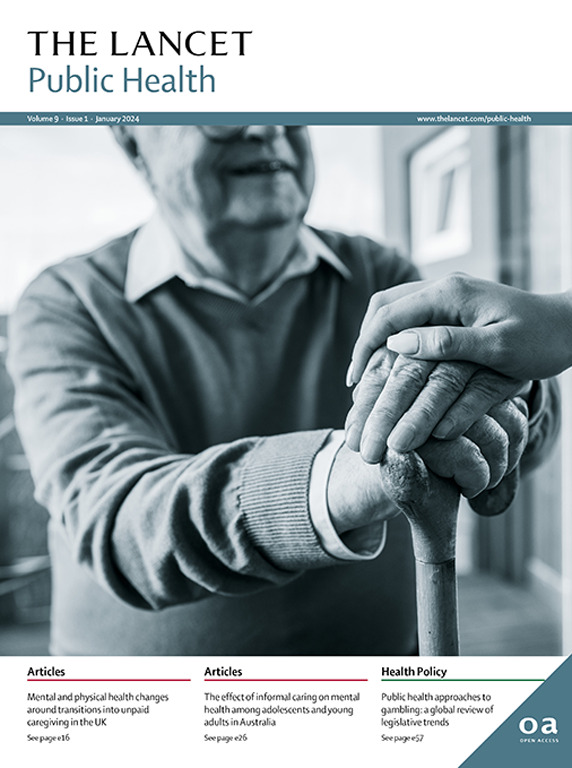墨西哥的酒精与死亡率:对 15 万成年人的前瞻性研究
IF 25.4
1区 医学
Q1 PUBLIC, ENVIRONMENTAL & OCCUPATIONAL HEALTH
引用次数: 0
摘要
墨西哥城前瞻性研究在 1998 年至 2004 年间招募了 15 万名 35 岁或以上的成年人。对参与者进行了跟踪调查,直至 2022 年 10 月 1 日,以了解特定原因导致的死亡率。对入选时未自我报告慢性病的参与者(已对年龄、性别、地区、教育程度、体力活动、吸烟和糖尿病进行调整)采用 Cox 回归法,将基线报告的饮酒量(从不、曾经、偶尔[少于每月一次]和经常[至少每月一次,分为≥70 克/周、≥70 克/周至≥140 克/周、≥140 克/周至≥210 克/周])与 35-74 岁时因各种原因和预先指定的与酒精相关的一组潜在原因导致的死亡率联系起来。研究还对大量偶发性饮酒(通常一次饮酒5杯[男性]或4杯[女性])和首选饮酒类型进行了调查。研究结果在招募时年龄为35-74岁的138 413名参与者中,有21 136人(15%)经常饮酒(男性14 863人[33%],女性6273人[7%]),其中13 383人(63%)喜欢烈性酒,6580人(31%)喜欢啤酒。在随访期间,35-74 岁年龄段共有 13 889 人死亡,其中 3067 人死于与酒精相关的预设原因。总体而言,酒精与死亡率呈 "J "型关系。与偶尔饮酒者相比,基线报告消费量≥210 克/周者的全因死亡率高出 43%(比率比 [RR] 1-43 [95% CI 1-30-1-56]),与酒精相关的预设死因死亡率高出近三倍(2-77 [2-39-3-20])。肝病导致的死亡与饮酒量密切相关;每周饮酒量≥140 克的经常饮酒者与偶尔饮酒者相比,RR 为 4-03 (3-36-4-83)。与偶尔少量饮酒相比,偶尔大量偶发性饮酒与酒精相关的死亡率高出20%(1-20 [1-06-1-35]),而经常大量偶发性饮酒与酒精相关的死亡率高出89%(1-89 [1-67-2-15])。在这一墨西哥人群中,较高的酒精消耗量、偶发性饮酒和极高比例的酒精产品都与死亡率的增加有关。资助韦尔科姆基金会、墨西哥卫生部、墨西哥国家科技委员会、英国癌症研究中心、英国心脏基金会和英国医学研究委员会。本文章由计算机程序翻译,如有差异,请以英文原文为准。
Alcohol and mortality in Mexico: prospective study of 150 000 adults
Background
Alcohol consumption is a leading cause of premature death globally, but there is no large-scale prospective evidence from Mexico.Methods
The Mexico City Prospective Study recruited 150 000 adults aged 35 years or older between 1998 and 2004. Participants were followed up until Oct 1, 2022 for cause-specific mortality. Cox regression in those with no self-reported chronic disease at entry (adjusted for age, sex, district, education, physical activity, smoking, and diabetes) was used to relate baseline-reported alcohol consumption (never, former, occasional [less than monthly], and regular [at least monthly, split into <70, ≥70 to <140, ≥140 to <210, and ≥210 g/week]) to mortality at ages 35–74 from all causes, and from a pre-specified alcohol-related set of underlying causes. Heavy episodic drinking (normally consuming >5 [men] or >4 [women] drinks on a single occasion) and type of preferred drink were also examined.Findings
Among 138 413 participants aged 35–74 years at recruitment, 21 136 (15%) were regular alcohol drinkers (14 863 [33%] men, 6273 [7%] women), of whom 13 383 (63%) favoured spirits and 6580 (31%) favoured beer. During follow-up, there were 13 889 deaths at ages 35–74 years, including 3067 deaths from the pre-specified alcohol-related causes. Overall, J-shaped associations with mortality were observed. Compared with occasional drinkers, those with baseline-reported consumption ≥210 g/week had 43% higher all-cause mortality (rate ratio [RR] 1·43 [95% CI 1·30–1·56]) and nearly three times the mortality from the pre-specified alcohol-related causes (2·77 [2·39–3·20]). Death from liver disease was strongly related to alcohol consumption; the RR comparing regular drinkers of ≥140 g/week with occasional drinkers was 4·03 (3·36–4·83). Compared with occasional light drinking, occasional heavy episodic drinking was associated with 20% higher alcohol-related mortality (1·20 [1·06–1·35]), and regular heavy episodic drinking was associated with 89% higher alcohol-related mortality (1·89 [1·67–2·15]). Drinks with alcohol percentages higher than spirits were associated with the greatest increased mortality risk, even after accounting for the total alcohol consumed.Interpretation
In this Mexican population, higher alcohol consumption, episodic drinking, and very high percentage alcoholic products were all associated with increased mortality.Funding
Wellcome Trust, the Mexican Health Ministry, the National Council of Science and Technology for Mexico, Cancer Research UK, British Heart Foundation, and the UK Medical Research Council.Translation
For the Spanish translation of the abstract see Supplementary Materials section.求助全文
通过发布文献求助,成功后即可免费获取论文全文。
去求助
来源期刊

Lancet Public Health
Medicine-Public Health, Environmental and Occupational Health
CiteScore
55.60
自引率
0.80%
发文量
305
审稿时长
8 weeks
期刊介绍:
The Lancet Public Health is committed to tackling the most pressing issues across all aspects of public health. We have a strong commitment to using science to improve health equity and social justice. In line with the values and vision of The Lancet, we take a broad and inclusive approach to public health and are interested in interdisciplinary research.
We publish a range of content types that can advance public health policies and outcomes. These include Articles, Review, Comment, and Correspondence. Learn more about the types of papers we publish.
 求助内容:
求助内容: 应助结果提醒方式:
应助结果提醒方式:


